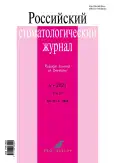Метод армирования зубов при разрушении коронковой части зуба
- Авторы: Воробьева Ю.Б.1, Железняк В.А.1, Щенникова М.Н.1, Поплаухин Т.С.1
-
Учреждения:
- Военно-медицинская академия имени С.М. Кирова
- Выпуск: Том 27, № 4 (2023)
- Страницы: 271-279
- Раздел: Экспериментально-теоретические исследования
- URL: https://bakhtiniada.ru/1728-2802/article/view/253504
- DOI: https://doi.org/10.17816/dent296333
- ID: 253504
Цитировать
Аннотация
Обоснование. Одним из способов улучшения качества восстановления коронковой части зуба является использование армирующего компонента, увеличивающего прочность и долговечность реставрации жевательной группы зубов.
Цель исследования — предложить новый метод восстановления обширных дефектов твёрдых тканей зубов с дополнительным армированием.
Материалы и методы. В ходе работы было использовано 100 удалённых по различным показаниям зубов жевательной анатомо-функциональной принадлежности. Кариозные полости всех зубов после удаления препарировали под полости I класса по Блэку. Проводили измерение толщины стенок при помощи стоматологического микрометра, толщина стенок половины зубов (50) составляла более 3 мм, половины (50) — менее 3 мм. На основании измерений рассчитали, как в зубе будет распределяться нагрузка, исходя из чего был определён оптимальный способ установки нити с композитом в полость зуба с целью увеличения прочности реставрации. Применялись: адгезив стоматологический Single Bond Universal в отдельных упаковках; материал стоматологический композитный 3M ESPE Filtek Ultimate Universal Restorative; нить с композитным материалом (волокно стоматологическое светоотверждаемое формированное «Гусеница»), также в ходе работы использовали стоматологический микрометр; оборудование лабораторное электрическое: испытательную машину, твердомер торговой марки Shimadzu; лампу светополимеризационную стоматологическую Ledex, модель WL-070; лабораторный микроскоп Carl Zeiss Primo Star; эмиссионный растровый электронный микроскоп Merlin (Zeiss).
Результаты. При исследовании на максимальную силу сжатия и напряжения лабораторным путём доказано, что зубы, восстановленные при помощи сочетания нити с композитом и композитного материала, выдерживают более высокую механическую нагрузку, чем зубы, восстановленные исключительно композитным материалом.
Заключение. Разработан «Способ реставрации моляров в случае значительного разрушения коронковой части зуба» (патент РФ № 2783060). Предложен метод восстановления обширных дефектов коронковой части зуба с использованием композитной ленты как армирующего компонента. При анализе результатов исследования на разрывной машине Shimadzu выявлено, что реставрации, проведённые с использованием композитной нити, являются более прочными и, соответственно, долговечными, нежели аналогичные терапевтические восстановления формы и функции зуба, проведённые без использования нити с композитом.
Полный текст
Открыть статью на сайте журналаОб авторах
Юлия Борисовна Воробьева
Военно-медицинская академия имени С.М. Кирова
Email: doctor32@bk.ru
ORCID iD: 0000-0003-0394-7868
к.м.н., доцент
Россия, 194044, г. Санкт-Петербург, ул. Академика Лебедева, 6Владимир Андреевич Железняк
Военно-медицинская академия имени С.М. Кирова
Email: zhva73@yandex.ru
ORCID iD: 0000-0002-6597-4450
к.м.н., доцент, начальник кафедры
Россия, 194044, г. Санкт-Петербург, ул. Академика Лебедева, 6;Марина Николаевна Щенникова
Военно-медицинская академия имени С.М. Кирова
Email: marina_75.08@mail.ru
ORCID iD: 0000-0003-4805-2304
преподаватель
Россия, 194044, г. Санкт-Петербург, ул. Академика Лебедева, 6;Тарас Сергеевич Поплаухин
Военно-медицинская академия имени С.М. Кирова
Автор, ответственный за переписку.
Email: taraspoplau@gmail.com
ORCID iD: 0000-0001-9117-5874
преподаватель
Россия, 194044, г. Санкт-Петербург, ул. Академика Лебедева, 6;Список литературы
- Гайворонский И.В., Петрова Т.Б. Анатомия зубов человека. Санкт-Петербург : Элби-СПб, 2017.
- Адилханян В.А. Особенности восстановления зубов после эндодонтического лечения : дис. … канд. мед. наук. Москва, 2003.
- Крутов В.А. Эффективность использования эластичных штифтов и композитных материалов для реконструкции разрушенных зубов после эндодонтического лечения : автореф. дис. … канд. мед. наук. Санкт-Петербург, 2013.
- Кореневская Н.А. Постэндодонтическая реставрация в стоматологии. Витебск : ВГМУ, 2018.
- Факультетская стоматология / под ред. А.К. Иорданишвили, А.М. Ковалевского. Москва : СИМК, 2015.
- Вишняков Н.И., Данилов Н.О., Прозорова Н.В. Изучение заболеваемости кариесом зубов по данным обращаемости населения за стоматологической помощью // Вестник Санкт-Петербургского университета. Медицина. 2007. № 4. С. 133–142.
- Николаенко С.А. Современные аспекты реставрации твёрдых тканей зубов. Санкт-Петербург : МЕДИ, 2007.
- Попова Е.А., Фурцев Т.В. Исследование прочности адгезионного соединения композиционного материала и дентина в зависимости от вида обработки полости зуба // Российский стоматологический журнал. 2016. Т. 20, № 2. С. 63–65. doi: 10.18821/1728-28022016;20(2)63-65
- Патент РФ на изобретение № 2479278 C2/ 20.04.13. Кукушкин В.Л., Кукушкина Е.А., Никулина В.Ю. Способ реставрации коронки зуба.
- Патент РФ на изобретение № 2783060/ 08.11.22. Воробьёва Ю.Б., Железняк В.А., Габараева А.Ш. Способ реставрации моляров в случае разрушения коронковой части зуба.
Дополнительные файлы




















